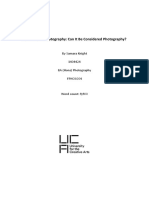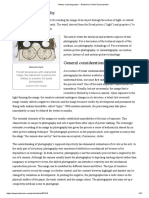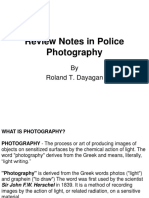Damisch Five Notes
Damisch Five Notes
Uploaded by
ella daniCopyright:
Available Formats
Damisch Five Notes
Damisch Five Notes
Uploaded by
ella daniOriginal Title
Copyright
Available Formats
Share this document
Did you find this document useful?
Is this content inappropriate?
Copyright:
Available Formats
Damisch Five Notes
Damisch Five Notes
Uploaded by
ella daniCopyright:
Available Formats
Five Notes for a
Phenomenology of the
Photographic Image *
HUBERT DAMISCH
1. Theoretically speaking, photography is nothing other than a process of
recording, a technique of inscribing, in an emulsion of silver salts, a stable image
generated by a ray of light. This definition, we note, neither assumes the use of a
camera, nor does itimply that the image obtained is that of an object or scene from
the external world. We know of prints obtained from film directly exposed to a
light source. The prime value of this type of endeavor is to induce a reflection on
the nature and function of the photographic image. And insofar as it successfully
eliminates one of the basic elements of the very idea of "photography" (the camera
obscura, the camera), it produces an experimental equivalent of a phenomenolo-
gical analysis which purports to grasp the essence of the phenomenon under
consideration by submitting that phenomenon to a series of imaginary variations.
2. The reluctance one feels, however, in describing such images as pho-
tographs is a revealing indication of the difficulty of reflecting phe-
nomenologically-in the strict sense of an eidetic experience, a reading of
essences-on a cultural object, on an essence that is historically constituted.
Moreover, the full purview of a photographic document clearly involves a certain
number of "theses" which, though not of a transcendental order, appear neverthe-
less as the conditions for apprehending the photographic image as such. To
consider a document of this sort like any other image is to claim a bracketing of all
knowledge-and even, as we shall see, of all prejudice-as to its genesis and
empirical functions. It therefore follows that the photographic situation cannot be
defined a priori, the division of its fundamental components from its merely
contingent aspects cannot be undertaken in the absolute.
The photographic image does not belong to the natural world. It is a
product of human labor, a cultural object whose being-in the phenomenological
sense of the term-cannot be dissociated precisely from its historical meaning and
from the necessarily datable project in which it originates. Now, this image is
characterized by the way in which it presents itself as the result of an objective
* First published in L'Arc (Paris), 1963.
71
process. Imprinted by rays of light on a plate or sensitive film, these figures (or
better perhaps, these signs?) must appear as the very trace of an object or a scene
from the real world, the image of which inscribes itself, without direct human
intervention, in the gelatinous substance covering the support. Here is the source
ofl the supposition of "reality," which defines the photographic situation. A
photograph is this paradoxical image, without thickness or substance (and, in a
way, entirely unreal), that we read without disclaiming the notion that it retains
something of the reality from which it was somehow released through its physio-
chemical make-up. This is the constitutive deception of the photographic image
(it being understood that every image, as Sartre has shown, is in essence a deceit).
In the case of photography, however, this ontological deception carries with it a
historical deceit, far more subtle and insidious. And here we return to that object
which we got rid of a little too quickly: the black box, the photographic camera.
3. Niepce, the successive adepts of the Daguerreotype, and those innumer-
able inventors who made photography what it is today, were not actually
concerned to create a new type of image or to determine novel modes of
representation; they wanted, rather, to fix the images which "spontaneously"
formed on the ground of the camera obscura. The adventure of photography
begins with man's first attempts to retain that image he had long known how to
make. (Beginning in the 11th century, Arab astronomers probably used the camera
obscura to observe solar eclipses.) This long familiarity with an image so
produced, and the completely objective, that is to say automatic or in any case
strictly mechanical, appearance of the recording process, explains how the
photographic representation generally appeared as a matter of course, and why
one ignores its highly elaborated, arbitrary character. In discussions of the
invention of film, the history of photography is most frequently presented as that
of a discovery. One forgets, in the process, that the image the first photographers
were hoping to seize, and the very latent image which they were able to reveal and
develop, were in no sense naturally given; the principles of construction of the
photographic camera-and of the camera obscura before it-were tied to a
conventional notion of space and of objectivity whose development preceded the
invention of photography, and to which the great majority of photographers only
conformed. The lens itself, which had been carefully corrected for "distortions"
and adjusted for "errors," is scarcely as objective* as it seems. In its structure and
in the ordered image of the world it achieves, it complies with an especially
familiar though very old and delapidated system of spatial construction, to which
photography belatedly brought an unexpected revival of current interest.
(Would the art, or rather the craft, of photography not consist partly in
allowing us to forget that the black box is not "neutral" and that its structure is
not impartial?)
* The play here is on the French word for lens: objectif.-ed.
72 OCTOBER
4. The retention of the image, its development and multiplication, form an
ordered succession of steps which composed the photographic act, taken as a
whole. History determined, however, that this act would find its goal in reproduc-
tion, much the way the point of film as spectacle was established from the start.
(We know that the first inventors worked to fix images and simultaneously to
develop techniques for their mass distribution, which is why the process perfected
by Daguerre was doomed from the very outset, since it could provide nothing but a
unique image). So that photography's contribution, to use the terms of classical
economy, is less on the level of production, properly speaking, than on that of
consumption. Photography creates nothing of "use" (aside from its marginal and
primarily scientific applications); it rather lays down the premises of an unbridled
destruction of utility. Photographic activity, even though it generally takes the
form of craft, is nonetheless, in principle, industrial; and this implies that of all
images the photographic one-leaving aside its documentary character-wears
out the most quickly. But it is important to note that even when it gives us,
through the channels of publishing, advertising, and the press, only those images
which are already half consumed, or so to speak, "predigested," this industry
fulfills the initial photographic project: the capturing and restoration of an image
already worn beyond repair, but still, through its physical nature, unsuited to
mass consumption.
5. Photography aspires to art each time, in practice, it calls into question its
essence and its historical roles, each time it uncovers the contingent character of
these things, soliciting in us the producer rather than the consumer of images. (It
is no accident that the most beautiful photograph so far achieved is possibly the
first image Nicephore Niepce fixed in 1822, on the glass of the camera obscura-a
fragile, threatened image, so close in its organization, its granular texture, and its
emergent aspect, to certain Seurats-an incomparable image which makes one
dream of a photographic substance distinct from subject matter, and of an art in
which light creates its own metaphor.)
You might also like
- Stillness and Time. Photography and The Moving ImageDocument93 pagesStillness and Time. Photography and The Moving ImageCamila Cárdenas Neira50% (2)
- Miriam Hansen's Introduction Kracauer's "Theory of Film"Document20 pagesMiriam Hansen's Introduction Kracauer's "Theory of Film"dbluherNo ratings yet
- Green, David - Marking Time. Photography, Film and Temporalities of The ImageDocument7 pagesGreen, David - Marking Time. Photography, Film and Temporalities of The ImagelautxapNo ratings yet
- Warburton, N. - PhotographyDocument16 pagesWarburton, N. - PhotographyAndreea Mitreanu100% (5)
- Photo Narrative, Sequential Photography, Photonovels: AN Aetens Ieke LeyenDocument18 pagesPhoto Narrative, Sequential Photography, Photonovels: AN Aetens Ieke LeyenDac Truong Nguyen100% (1)
- Szarkowski - The Photographers EyeDocument9 pagesSzarkowski - The Photographers Eyeapi-35620112No ratings yet
- Assessing Gender Bias in Machine Translation: A Case Study With Google TranslateDocument19 pagesAssessing Gender Bias in Machine Translation: A Case Study With Google TranslateXiaoyi ChengNo ratings yet
- Methyl Acetate Project DesignDocument36 pagesMethyl Acetate Project Designdjona lokimaNo ratings yet
- Camera Less Photography Can It Be Considered Photography.Document33 pagesCamera Less Photography Can It Be Considered Photography.st_jovNo ratings yet
- Bourdieu P. Photography - A Middle-Brow Art - 73-98Document16 pagesBourdieu P. Photography - A Middle-Brow Art - 73-98Богдан ТушевскийNo ratings yet
- History of Photography - Britannica Online EncyclopediaDocument30 pagesHistory of Photography - Britannica Online EncyclopediaIulia-Dana PuscasuNo ratings yet
- Moholy-Nagy Laszlo Painting Photography Film-Pages-25-27Document3 pagesMoholy-Nagy Laszlo Painting Photography Film-Pages-25-27김지원No ratings yet
- Photography As Performative ProcessDocument11 pagesPhotography As Performative ProcessStanciu ElenaNo ratings yet
- The Impact of The Use of Photography As An Aid When Painting A PortraitDocument22 pagesThe Impact of The Use of Photography As An Aid When Painting A PortraitLaura Jessica BellNo ratings yet
- Thedevelopmentofaphotographicaesthetic inOJADDocument13 pagesThedevelopmentofaphotographicaesthetic inOJADDAVID SANTIAGO AGUIRRE CANONo ratings yet
- Hecht - 2005 - Film As Event PerceptionDocument28 pagesHecht - 2005 - Film As Event PerceptioniroirofilmsNo ratings yet
- Introduction To PhotojournalismDocument60 pagesIntroduction To Photojournalismbabalolaidowu500No ratings yet
- Thierry de Duve - The Photograph As Paradox PDFDocument14 pagesThierry de Duve - The Photograph As Paradox PDFAde EvaristoNo ratings yet
- Birgit Hein Structural FilmDocument13 pagesBirgit Hein Structural FilmJihoon Kim100% (1)
- Chapter 6Document18 pagesChapter 6Ryan SuarezNo ratings yet
- Charles Harbutt EssayDocument10 pagesCharles Harbutt EssayAhsan Ali100% (1)
- Lesson 1.2Document16 pagesLesson 1.2Ryan Christopher C. LimNo ratings yet
- Following in The Visual Footstep - Investigating Value of The Photographic Medium in Modern Industrialized CultureDocument14 pagesFollowing in The Visual Footstep - Investigating Value of The Photographic Medium in Modern Industrialized CultureTimothy MahrNo ratings yet
- Paper On The Camera As The Photographer's VoiceDocument12 pagesPaper On The Camera As The Photographer's VoiceAlisa ZykovaNo ratings yet
- Pictorialism: Mailing 2: - ADocument13 pagesPictorialism: Mailing 2: - ACaius Ovidiu Merșa100% (1)
- CHEMIGRAMSDocument9 pagesCHEMIGRAMSproushNo ratings yet
- In Plato's Cave Susan SontagDocument3 pagesIn Plato's Cave Susan SontagAkbar HassanNo ratings yet
- Film Is An ArtDocument16 pagesFilm Is An ArtKhaidir KaddaviNo ratings yet
- Module 7 ArtApp 103Document13 pagesModule 7 ArtApp 103Berna QuiambaoNo ratings yet
- 03 Megan Slatoff BurkeDocument6 pages03 Megan Slatoff BurkeMassimiliano FaillaNo ratings yet
- John Berger - Uses of PhotographyDocument7 pagesJohn Berger - Uses of PhotographyScribdTranslationsNo ratings yet
- Film TheoryDocument35 pagesFilm TheoryTanisha Vella100% (1)
- PhotographyDocument33 pagesPhotographyAnnhe BucalNo ratings yet
- Walter Benjamin - A Short History of PhotographyDocument22 pagesWalter Benjamin - A Short History of PhotographyOlgu KundakçıNo ratings yet
- Photography As A Perfomative ProccessDocument11 pagesPhotography As A Perfomative ProccessSilver 101010 (silver10)No ratings yet
- Metapresentation Kella FinalDocument3 pagesMetapresentation Kella FinalMarjaana KellaNo ratings yet
- S P NotesDocument23 pagesS P NotesDiya KapoorNo ratings yet
- Review Notes in Police PhotographyDocument203 pagesReview Notes in Police PhotographyCRIMY PIENo ratings yet
- Virtual Photography: Artificial Intelligence, In-game, and Extended RealityFrom EverandVirtual Photography: Artificial Intelligence, In-game, and Extended RealityAli ShobeiriNo ratings yet
- Photography As Performative ProcessDocument12 pagesPhotography As Performative Processannashin203No ratings yet
- Photography by DayaganDocument243 pagesPhotography by DayaganClaudine Gubia-on PuyaoNo ratings yet
- 01 1 Kracauer Basic Concepts Theory of FilmDocument12 pages01 1 Kracauer Basic Concepts Theory of FilmElidio La Torre Lagares67% (3)
- Photography and FetishDocument11 pagesPhotography and FetishAndra Vranceanu100% (1)
- Geofrey Batchen EmanationsDocument22 pagesGeofrey Batchen EmanationsIbon Lemura100% (1)
- Review Notes in Police Photography: by Roland T. DayaganDocument208 pagesReview Notes in Police Photography: by Roland T. DayaganClaudine Gubia-on Puyao100% (1)
- FOSC 1 Lecture Ca 2Document11 pagesFOSC 1 Lecture Ca 2ma.cecilia.pejiNo ratings yet
- Atestat EnglezaDocument13 pagesAtestat Englezai feel like SykoNo ratings yet
- Forensic PhotographyDocument14 pagesForensic Photographyaira.esporaNo ratings yet
- Solomon God Eau Who Is Speaking ThusDocument16 pagesSolomon God Eau Who Is Speaking Thusbunnygamer100% (2)
- 3.the Cinema and Social Science. A Survey of Ethnographic and Sociological FilmsDocument59 pages3.the Cinema and Social Science. A Survey of Ethnographic and Sociological FilmsAna CienfuegosNo ratings yet
- J. L. Baudry - Ideological Effects of The Basic Cinematographic ApparatusDocument9 pagesJ. L. Baudry - Ideological Effects of The Basic Cinematographic ApparatusWilson SantosNo ratings yet
- Jean Louis Baudry Ideological Effects Cinema ApparatusDocument9 pagesJean Louis Baudry Ideological Effects Cinema ApparatusTicianoNo ratings yet
- What A Documentary Is After AllDocument14 pagesWhat A Documentary Is After AllPatrícia NogueiraNo ratings yet
- Baudry Jean Louis - Ideological Effects of The Basic Cinematographic Apparatus PDFDocument10 pagesBaudry Jean Louis - Ideological Effects of The Basic Cinematographic Apparatus PDFStefaniaAONo ratings yet
- Photography HandoutDocument4 pagesPhotography HandoutAmandaNo ratings yet
- Review Notes in Police PhotographyDocument203 pagesReview Notes in Police PhotographyInaho KaizugaNo ratings yet
- Orca Share Media1672405568765 7014577366695866237Document20 pagesOrca Share Media1672405568765 7014577366695866237Flora Mae ArcadioNo ratings yet
- Forensic 1 (Chapter 1) PDFDocument50 pagesForensic 1 (Chapter 1) PDFKaren Narvadez GutierrezNo ratings yet
- Le Corbusier and PhotographyDocument19 pagesLe Corbusier and PhotographyBruno YanagizawaNo ratings yet
- Law Enforcement Administration ReviewDocument135 pagesLaw Enforcement Administration Reviewjiug.jualo.cocNo ratings yet
- Jacques Ranciere Film Fables 1Document186 pagesJacques Ranciere Film Fables 1ella daniNo ratings yet
- Simon Schama Landscape and Memory Chapters 1 2Document156 pagesSimon Schama Landscape and Memory Chapters 1 2ella dani100% (2)
- Roland Barthes Mythologies The New CitroenDocument2 pagesRoland Barthes Mythologies The New Citroenella daniNo ratings yet
- Posthumanism in Late Soviet Science FictionDocument70 pagesPosthumanism in Late Soviet Science Fictionella daniNo ratings yet
- Repopulating The Street Contemporary Photography and Urban ExperienceDocument13 pagesRepopulating The Street Contemporary Photography and Urban Experienceella daniNo ratings yet
- Paul Strand PhotographyDocument4 pagesPaul Strand Photographyella daniNo ratings yet
- Reinventing The Genre New Topographics ADocument18 pagesReinventing The Genre New Topographics Aella dani100% (1)
- Flusser GesturesDocument104 pagesFlusser Gesturesella daniNo ratings yet
- 41810620Document17 pages41810620ella daniNo ratings yet
- Szanyi AgnesDocument53 pagesSzanyi Agnesella daniNo ratings yet
- 941-Article Text-3025-3162-10-20201218Document16 pages941-Article Text-3025-3162-10-20201218ella daniNo ratings yet
- 01 Eagar Becoming Iconic David Bowie 2014Document5 pages01 Eagar Becoming Iconic David Bowie 2014ella daniNo ratings yet
- Becoming Iconic: David Bowie From Man To Icon: January 2014Document8 pagesBecoming Iconic: David Bowie From Man To Icon: January 2014ella daniNo ratings yet
- The Art Market Global Economy and Information TranDocument22 pagesThe Art Market Global Economy and Information Tranella daniNo ratings yet
- Vieta's Formulas HandoutDocument14 pagesVieta's Formulas HandoutVardayineeNo ratings yet
- Dickinson PoemDocument19 pagesDickinson PoemTwinkle SoniNo ratings yet
- MP - Multiplex CommunicationDocument61 pagesMP - Multiplex CommunicationWilly NozatoNo ratings yet
- LET Reviewer RizalDocument6 pagesLET Reviewer RizalJoong Seo69% (13)
- jbpm3 2 2-HandsontutorialDocument99 pagesjbpm3 2 2-HandsontutorialkdorairajsgNo ratings yet
- Comparative Study of Two Cars DFT To SendDocument146 pagesComparative Study of Two Cars DFT To SendAnuj TiwariNo ratings yet
- Module 7 O.C. & As # 7Document9 pagesModule 7 O.C. & As # 7Angelica OrbizoNo ratings yet
- Acceptance SpeechDocument3 pagesAcceptance SpeechElija Fernan De JesusNo ratings yet
- Nicholas Cook (Editor), Richard Pettengill (Editor) - Taking It To The Bridge - Music As Performance-University of Michigan Press (2013) - 87-102Document16 pagesNicholas Cook (Editor), Richard Pettengill (Editor) - Taking It To The Bridge - Music As Performance-University of Michigan Press (2013) - 87-102EmmyAltavaNo ratings yet
- Priyanka Dharmraj Resume - 28-03-2023Document5 pagesPriyanka Dharmraj Resume - 28-03-2023Girish LheruNo ratings yet
- Annex A (Ref: CSIQP 5.2.1 Overall Process Sequence & Interaction Flow Chart)Document1 pageAnnex A (Ref: CSIQP 5.2.1 Overall Process Sequence & Interaction Flow Chart)VVVVVVNo ratings yet
- 2023 ESKAS All Country Contacts A To Z For Application DocumentsDocument22 pages2023 ESKAS All Country Contacts A To Z For Application DocumentsSonam ChoekiNo ratings yet
- Account Statement 20 May 2024-02 Jun 2024Document3 pagesAccount Statement 20 May 2024-02 Jun 2024Parveen KumarNo ratings yet
- HLD RRCDocument166 pagesHLD RRCafroxxxNo ratings yet
- Robotics MotionDocument29 pagesRobotics MotionfenixnomahotmailcomNo ratings yet
- Hairdressing Just Hair EnglishDocument157 pagesHairdressing Just Hair EnglishRizwan MustafaNo ratings yet
- 11 Paths To ModernisationDocument20 pages11 Paths To ModernisationGouri NandhanaNo ratings yet
- Reading Plus Unit 1Document27 pagesReading Plus Unit 1Anonymous SFTeXFdnNo ratings yet
- Letter For Validators 1Document12 pagesLetter For Validators 1Desiree FilloneNo ratings yet
- Data Handling Using Pandas I - SeriesDocument11 pagesData Handling Using Pandas I - SeriesUV DabNo ratings yet
- Format For Thesis Project ReportDocument2 pagesFormat For Thesis Project ReportendoparasiteNo ratings yet
- 2-Osteomyelitis and Septic ArthritisDocument34 pages2-Osteomyelitis and Septic Arthritisomarsoo7gNo ratings yet
- Laura Davis - The Courage To Heal Workbook - A Guide For Women and Men Survivors of Child Sexual Abuse (1990) PDFDocument484 pagesLaura Davis - The Courage To Heal Workbook - A Guide For Women and Men Survivors of Child Sexual Abuse (1990) PDFClarissa P100% (9)
- Common Errors in The Use of AdjectivesDocument34 pagesCommon Errors in The Use of AdjectivesClark Harvey BautistaNo ratings yet
- Engine PPT 1Document17 pagesEngine PPT 1Ankit KumarNo ratings yet
- R 5Document70 pagesR 5vacdigital100% (1)
- Chemistry Student Experiment Assessment TaskDocument3 pagesChemistry Student Experiment Assessment TasknoNo ratings yet
- L4 - SkinsDocument52 pagesL4 - SkinsJIA YUET NGNo ratings yet







































































































